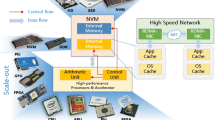Abstract.
Collaborative virtual environments are rapidly gaining in popularity for the implementation of intuitive workspaces and networked gaming environments. Primary challenges that have to be addressed by these systems are maintaining systemwide data consistency, enabling fair resource sharing and interaction between users, and compensating network latency jitters. This paper investigates two major concurrency problems - (1) fair request handling and (2) systemwide data consistency. A global timestamp-based approach is presented in combination with different implementation models. Both centralized and decentralized approaches to achieving systemwide consistency and fairness are analyzed. To improve the scalability of the approach, hierarchical models are discussed. Implementation of a proof-of-concept system based on a high-level object-oriented real-time programming scheme called TMO is presented.
Similar content being viewed by others
References
Bierbaum A, Just C, Hartling P, Meinert K, Baker A, Cruz-Neira C (2001) VR Juggler: a virtual platform for virtual reality application development. In: Proceedings of the IEEE annual international symposium on virtual reality, 2001, pp 89-96
Carlsson C, Hagsand O (1993) DIVE: A multi-user virtual reality system. In: Proceedings of the IEEE annual international symposium on virtual reality, pp 394-400
Gautier L, Diot C, Kurose J (1999) End-to-end transmission control mechanisms for multiparty interactive applications on the internet. In: Proceedings of INFOCOM ‘99. IEEE Press, New York, 3:1470-1479
Gergeleit M, Streich H (1994) Implementing a distributed high-resolution realtime clock using the can-bus. In: Proceedings of the 1st international CANConference, Mainz, Germany. http://ais.gmd.de/RS/Papers/CAN-clock/CAN-clock.html
Greenhalgh C, Benford S (1995) Massive a distributed virtual reality system incorporating spatial trading. In: Proceedings of the 15th international conference on distributed computing systems, Vancouver, Canada. IEEE Press, New York, pp 27-34
Kim K, Kopetz H (1994) A real-time object model rto.k and an experimental investigation of its potentials. In: Proceedings of COMPSAC ‘94 (IEEE CS 1994 international conference on computer software and applications). IEEE Press, New York, pp 392-402
Kim K (1997) Object structures for real-time systems and simulatiors. IEEE Comput 30(8): 62-70
Kim K, Ishida M, Liu J (1999) An efficient middleware architecture supporting time-triggered message-triggered objects and an nt-based implementation. In: Proceedings of the 2nd international symposium on object-oriented realtime distributed computing (ISORC ‘99). IEEE Press, New York, pp 54-63
Kim K (2000) APIs for real-time distributed object programming. IEEE Comput 33(6): 72-80
Kim K, Paul R (2001) The distributed time-triggered simulation scheme facilitated by tmo programming. In: Proceedings of ISORC 2001. IEEE Press, New York, pp 41-50
Kim K, Im C, Athreya P (2002) Realization of a distributed os component for internal clock synchronization in a lan environment. In: Proceedings of the international symposium on object-oriented real-time distributed computing (ISORC). IEEE Press, New York, pp 263-270
Kim K (2004) Wide-area real-time computing in a tightly managed optical grid - an optiputer vision. In: Proceedings of the 18th international conference on advanced information networking and applications (AINA 2004). IEEE Press, New York, pp 2-11
Kopetz H, Damm A, Koza C, Mulazzani M, Schwabl W, Senft C, Zainlinger R (1989) Distributed fault-tolerant real-time systems the mars approach. IEEE Micro 30:25-40
Kopetz H (1997) Real-time systems design principles for distributed embedded applications. Kluwer, Dordrecht, pp 45-70
Leigh J, Johnson A, DeFanti T (1997) Cavern: a distributed architecture for supporting scalable persistence and interoperability in collaborative virtual environments. J Virtual Reality Res Develop Appl 2(2):217-237
Mills D (1991) Internet time synchronization the network time protocol. IEEE Trans Commun 39(10): 1482-1493
The Windows Time Service (2001) http://www.microsoft.com/windows2000/ techinfo/ howitworks/security/wintimeserv.asp, as of 02/04/2004
Nahrstedt K, Xu D, Wichadakul D, Li B (2001) Qos-aware middleware for ubiquitous and heterogeneous environments. IEEE Commun Mag 39(11): 140-148
NTP (2003) http://www.ntp.org, as of 02/04/2004
OMG (2004) http://www.omg.org/technology/documents/ specialized\_corba.htm, as of 02/04/2004
Park K, Cho Y, Krishnaprasad N, Scharver C, Lewis M, Leigh J, Johnson A (2000) CAVERNsoft G2: A toolkit for high performance tele-immersive collaboration. In: Proceedings of the symposium on virtual reality software and technology, pp 8-15
Purbrick J, Greenhalgh C (2002) An extensible event-based infrastructure for networked virtual worlds. In: Proceedings of the IEEE annual international symposium on virtual reality, pp 15-21
QuO (2002) http://quo.bbn.com, as of 02/04/2004
Ramjee R, Kurose J, Towsley D, Schulzrinne H (1994) Adaptive playout mechanisms for packetized audio applications in wide-area networks. In: Proceedings of INFOCOM ‘94. Networking for Global Communications, 2:680-688
Schmidt D, Levine D, Mungee S (1998) The design of the TAO real-time object request broker. Comput Commun 21(4):294-324
Schmalstieg D, Hesina G (2002) Distributed applications for collaborative augmented reality. In: Proceedings of the IEEE annual international symposium on virtual reality, pp 59-66
Singhal S, Zyda M (1999) Networked virtual environments - design and implementation. SIGGRAPH Series. ACM Press, New York
Smarr LL, Chien AA, Defanti T, Leigh J, Papadopoulos PM (2003) The OptIPuter. Commun ACM 46:59-67
TAO (2004) http://www.cs.wustl.edu/1~1schmidt/TAO.html, as of 02/04/2004
Thalmann NM, Capin T, Pandzic I, Thalmann D (1996) VLNET: A virtual life network for telecooperative applications. In: Proceedings of the spring conference on computer graphics (SCCG), pp 3-14
Tramberend H (1999) Avocado: a distributed virtual reality framework. In: Proceedings of the IEEE annual international symposium on virtual reality, pp 14-21
Waters R, Anderson D, Barrus J, Brogan D, Casey M, McKeown S, Nitta T, Sterns I, Yerazunis W (1996) Diamond park and spline A social virtual reality system with 3d animation, spoken interaction, and runtime modifiability. Technical Report TR-96-02, MERL, Cambridge, MA
Waters R (1996) Time synchronization in spline. Technical Report TR-96-09, MERL, Cambridge, MA
Watsen K, Zyda M (1998) Bamboo - a portable system for dynamically extensible, real-time, networked, virtual environments. In: Proceedings of Virtual Reality annual international symposium, pp 252-259
Author information
Authors and Affiliations
Corresponding author
Additional information
Published online: 22 February 2005
Rights and permissions
About this article
Cite this article
Kim, SJ., Kuester, F. & Kim, K.H.(. A global timestamp-based approach to enhanced data consistency and fairness in collaborative virtual environments. Multimedia Systems 10, 220–229 (2005). https://doi.org/10.1007/s00530-004-0153-4
Issue Date:
DOI: https://doi.org/10.1007/s00530-004-0153-4




